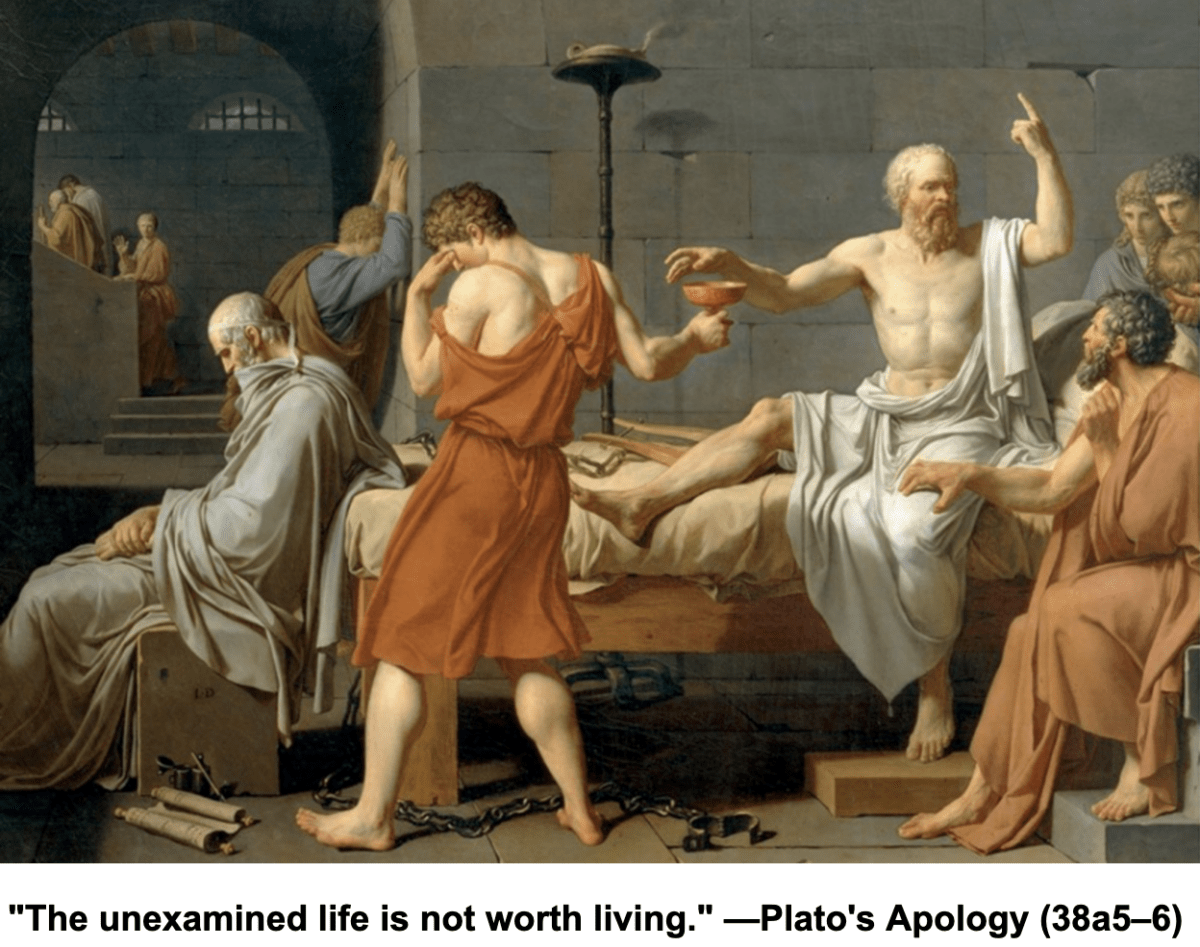Winston Churchill was a passionate student of history and wrote extensively on the subject, including celebrated multi-volume accounts of the two world wars. An important lesson he derived from his studies is captured in one of his most famous quotes: “The longer you can look back, the farther you can look forward.”
This mindset is a prerequisite to divining the meaning of biblical prophecies, which are less about the future and more about the past and what we need to learn from it. And there is no better illustration of this principle than the second oracle of Simeon chronicled in Luke.
As mandated by Exodus 13:2 and the statutes of Israel, the first-born son of every Jewish family had to be presented at the Temple in Jerusalem 40 days after birth. This practice harks back to Abel’s sacrifice of the firstling of the flock; the slaying of firstborn sons of the Egyptians was the means the Israelites were delivered from captivity. In earlier, pagan times, the first male had often been sacrificed to the tribal god, as the first-fruit of the family.[1] Hebrew law adapted this primitive custom by demanding the offering of five shekels, in order to “redeem” or buy back the child from God, to whom his life was owed.[2]
Thus, Joseph and Mary dutifully took the Christ child to Jerusalem to present him to the Lord. And they brought with them the requisite purification offering: two turtledoves/young pigeons. On this occasion, an upright and devout Jew called Simeon, who looked forward to the deliverance of Israel, met them in the Temple. It had been revealed to him that he would not die without seeing “the Lord’s Christ.” Taking the child in his arms, he pronounced his first oracle, which takes the form of a canticle or hymn:
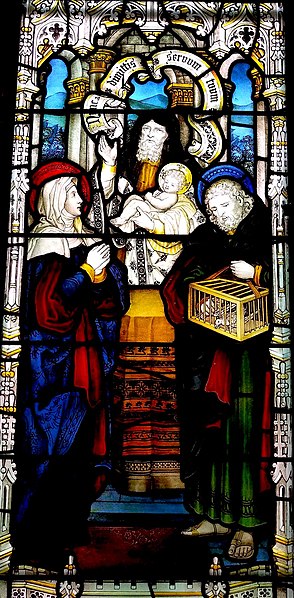
Simeon embraced the child in his arms and blessed God, saying: ‘Mighty Master, now you may let your servant depart in peace, since you have kept your word. For my eyes have seen this salvation that you made ready in the sight of all the peoples: a light to be a revelation to the Gentiles and to be a glory for your people in Israel.’
Luke 2:28-32, Raymond E. Brown translation.
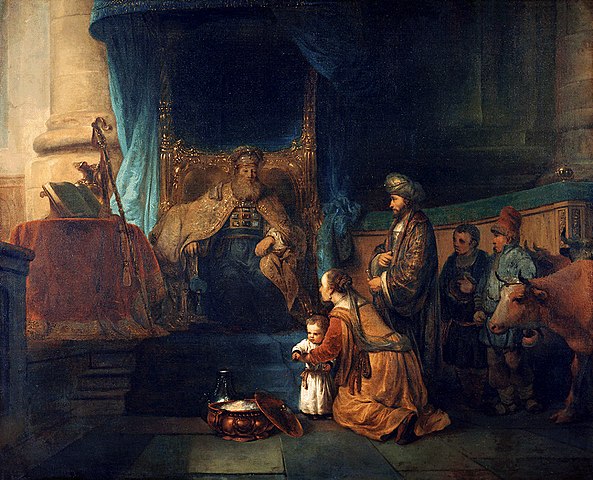
This story is intended to parallel a similar episode from the Old Testament: the presentation of Samuel in the Holy Sanctuary, which involved the boy’s parents, the child, and an elderly priest, Eli. By having Mary and Joseph present the baby Jesus, Luke is sending a message to the earliest Christians: the manifestation given to Simeon is a consequence of his obedience to the Law of Moses.[3]
After praising God for the fulfillment of this personal revelation, Simeon then pronounces his second oracle, which takes the form of a blessing and a prophecy:
Simeon blessed them and told Mary, his mother: ‘Behold, he is set for the fall and rise of many in Israel and for a sign to be contradicted [rejected]—indeed, a sword will pass through your own soul—so that the inmost thoughts of many people might be revealed.’
Luke 2:34-35 (Raymond Brown translation).
This passage is commonly misconstrued to mean that the sword of sorrow would pass through Mary’s soul when she witnessed the death of her son. Joseph Smith was also fond of this approach. When he revised this verse as part of his reworking of the Bible, he changed the word “sword” to “spear” and made Jesus, not Mary, the intended object of the weapon so as to create an obvious reference to the spear thrust into the side of the Savior while he was on the cross: “—Yea, a spear shall pierce through him to the wounding of thine own soul also, that the thoughts of many hearts may be revealed.”[4]
Most biblical scholars, however, reject this interpretation for several reasons.[5] First, it is based primarily on non-Lucan material. In Luke’s account of the crucifixion, Mary is never mentioned, and the women who followed Jesus from Galilee are portrayed as standing at a distance.[6] Mary only appears at the foot of the cross in John’s account, and there is no reason Luke’s audience would have been familiar with this story since John composed his gospel many years after Luke completed his own. Further, most scholars believe that this scene in John’s gospel (and many others) was an ahistorical literary creation, not a factual account of what actually transpired. This was a technique frequently employed by John to explain the purposes of Christ’s ministry.
Also, why would God wish to reveal to Mary the gruesome circumstances of her son’s death and the attendant sorrow she would experience? It is highly unlikely she could even comprehend such a revelation. More to the point, it would serve no theological or spiritual purpose.
We fail to comprehend Simeon’s second oracle because we are not well versed in the Old Testament. This sacred text was the lodestar for first century Jews in Palestine. It was the prism through which they processed the words of their religious leaders, something Luke—and Christ—clearly understood. The first two chapters of his gospel, and those of Matthew, are replete with Old Testament allusions. The Second Oracle of Simeon is no exception.
Simeon is echoing the words of Ezekiel 14:17 (KJV) where we read that the Lord, by the way of judgment, decrees: “Sword, go through the land; so that I cut off man and beast from it.” Ezekiel’s edict seems to have been well known since it is quoted in the Sibylline Oracles to describe the invasion of Egypt by Antiochus Epiphanes (ca. 170 B.C.): “For a sword will pass through the midst of you.”[7]
This is an image of a selective sword of judgment, destroying some and sparing others. It is used by Simeon to describe the impact Jesus will have upon the world: “he is set for the fall and rise of many in Israel and for a sign to be contradicted [rejected].”[8] Luke later reinforces this point when he quotes Christ as saying: “I have come for division. From now on in one house there will be five divided, three against two….”[9]
With this understanding, we see that Simeon is letting Mary know that this very same sword will pass through her own soul. Her privileged status as the earthly mother of the Savior will not excuse her from learning and studying the gospel and living her life in accordance with its precepts.
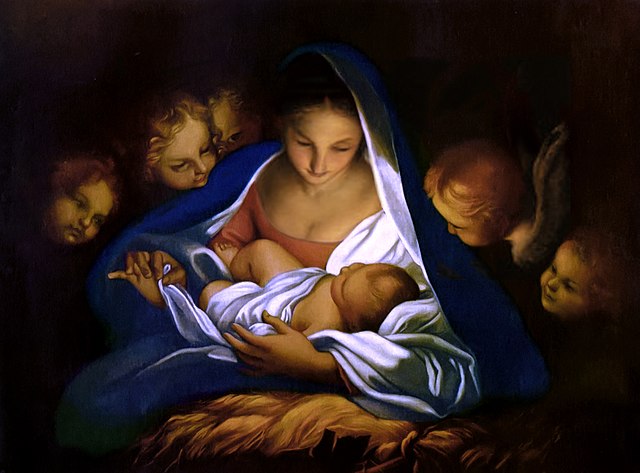
This message is later driven home in the scene where Mary and Christ’s brothers come seeking Jesus, only to have him reply that his true family consists not in a physical relationship but in a relationship with those who join him in consecrating their lives in the service of God the Father.[10] The message is clear: the demands of God are above the privilege of any human relationship.
Luke’s interest in Mary’s fate, as prophesied by Simeon, is consonant with his abiding concern for her welfare throughout his writings. And since Mary was the only adult in the infancy narrative who would live to see her son’s public ministry and the establishment of his Church,[11] Luke is hinting that later she would discover the meaning of all those things that she “pondered in her heart” at the time of the Savior’s birth.
Through Simeon’s oracle, Luke tells us that part of her discovery will be that she, too, will be judged by her son and that such judgment will be impartial and true. Since, however, Luke has already shown Mary doing the will of the Father at the time of the annunciation,[12] she will be a positive exception to the generally negative reaction in Israel that is the subject of Simeon’s prophecy. For her, Jesus will not be a sign to be rejected but one to be embraced and affirmed; and with that acceptance, she becomes the means by which “the inmost thoughts of many hearts will be revealed.”
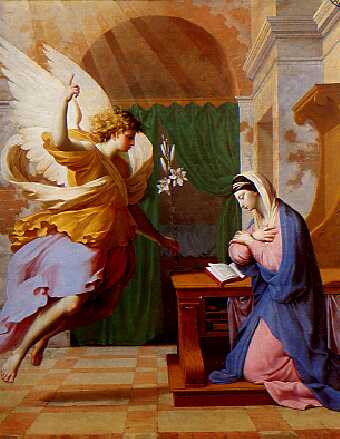
Many of the hearts whose thoughts are revealed by Mary’s example are our very own. Her faithfulness as a disciple of Christ is a worthy standard against which each of us can measure our own character.
It must have taken tremendous humility and courage to accept that the child you had taught and raised was in reality your elder brother. He was someone who Mary was being asked to follow, not lead—and to do so at times in the face of persecution without receiving preferential treatment. As the biblical scholar Raymond Brown observed, her greatness lies not in her biological connection with the Christ child but in the way she made “the decision to become a disciple by hearing God’s word and doing it.”[13]
[1] John Barton and John Muddiman, Editors, The Oxford Bible Commentary, (Oxford University Press: New York, 2001), p. 75.
[2] Raymond E. Brown, The Birth of the Messiah: A Commentary on the Infancy Narratives in the Gospels of Matthew and Luke, (New York: Doubleday, 1993), p. 447.
[3] 1 Sam 1:24-28. Ibid, pp. 450-451.
[4] Luke 2:35 JST. Smith’s change to this verse does not appear in the footnotes of the church’s edition of the King James version of the Bible. Indeed, several of his textual modifications were intentionally omitted by the church for reasons unknown. Moreover, none of Smith’s changes to the Bible have been canonized by the church, except for those parts found in the Pearl of Great Price. Bruce R. McConkie offered a word of caution regarding not only the JST but the chapter headings, the topical guide, and the Bible dictionary in our standard works: “None of these are perfect; they do not of themselves determine doctrine; there have been and undoubtedly now are mistakes in them.” Mark McConkie (editor), Doctrines of the Restoration: Sermons and Writings of Bruce R. McConkie (Salt Lake City, Utah: Bookcraft, 1989), 289–290.
[5] Brown, p. 464; Joseph A. Fitzmyer, S.J., The Gospel According to Luke (Garden City, NY: Doubleday & Co. Inc., 1981) p. Luke T. Johnson, The Gospel of Luke (Collegeville, MN: The Liturgical Press, 1991) p. 57; Robert J. Karris, O.F.M., “The Gospel According to Luke,” in The New Jerome Biblical Commentary, R.E. Brown, SS, et al. eds. (Englewood Cliffs, NJ: Prentice Hall, 1990) p. 684; R. Laurentin, The Truth About Christmas Beyond the Myths: The Gospel of the Infancy of Christ, trans. by Michael J. Wrenn (Peterson, Mass: St. Bede’s Publications, 1986) 79.
[6] Luke 23:49.
[7] Brown, 463-464.
[8] Luke 2:34.
[9] Luke 12:52 (ESV). See also Matt. 10:34. (“Think not that I am come to send peace on earth: I came not to send peace, but a sword.”)
[10] Luke 8:19-21.
[11] Acts 1:14.
[12] Luke 1:38.
[13] Raymond E. Brown, An Adult Christ at Christmas, (Collegeville, Minnesota: The Liturgical Press, 1988), pp. 35-36.
